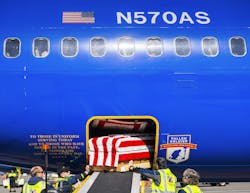The Mechanics of Alaska Airlines’ Fallen Soldier Program
This article is part of Ground Support Worldwide’s “Handling with Compassion” series, which looks at the respectful transportation of human remains, including military human remains.
Alaska Airlines had the honor of flying home one of the last Pearl Harbor survivors as he made his way to his final resting place. In March the remains of Naval Chief Petty Officer Richard Clyde Higgins were flown from Portland, Oregon, to Los Angeles.
Higgins enlisted in the United States Navy in 1939 and was radio operator at the time of the attack on Pearl Harbor. He served 20 years in the Navy, then continued in the Navy Reserve until 1970 and worked as an aeronautics engineer for defense contractors including Northrop Corporation (Northrop Grumman), where he worked on the B-2 Stealth Bomber.
When Higgins died at age 102, his family requested that Alaska Capt. Adrienne Grechman fly him home. Higgins met Grechman on an Honor Flight coming home from Honolulu, 80 years after the attack on Pearl Harbor and they had kept in touch.
Before the Higgins' final flight, Alaska Airlines employees took care of various arrangements at Portland International Airport (PDX) and Los Angeles International Airport (LAX).
“There were a lot of behind-the-scenes preparations,” says Kevin Kruse, an Alaska Airlines technician on-the-job-training instructor.
At PDX, Russ Prewitt, an aircraft technician trainer, led the ground team and coordinated everything for departure, including transportation for the family and Grechman from the hotel to the airport. At LAX, Dan Brosch, also an aircraft technician trainer, coordinated the arrival team. A third team from Alaska Airlines in Seattle, Washington, served as pall bearers at LAX.
“This was not a typical transfer,” says Kruse. “Many of our transfers are simple and quiet, with no family or military escort present.”
In those cases, he says, “we act as caretakers of the fallen [soldiers].”
In Seattle, where Alaska Airlines has its corporate headquarters, aircraft technicians handle military human remains (MHRs), and it was the aircraft maintenance group that developed the Alaska Airlines Fallen Soldier Program in 2011. Today the volunteer employee program has grown to include most of the airline’s work groups.
When aircraft maintenance staff are not available to assist with MHRs, ramp agents will assist. Now and then, that happens in Seattle, Kruse says, but in smaller stations, where there are just a few Alaska (or Horizon Air) mechanics or none at all, ramp agents handle the casket transfer.
Knowing exactly when people are going to be needed for an MHR is hard to predict – Kruse says weeks may pass without an MHR. Then in one week, there could be five.
MHR Protocols and Training
MHRs include three transfer scenarios: departure, thru-flight transfer and final destination.
“We have a document that spells out all the steps for handling a fallen soldier no matter what the scenario. That document is on our employee website, accessible to all employees regardless of the station they work at,” says Kruse, who serves as a Fallen Soldier Program volunteer and helped found the program.
A training video also is available. When there isn’t enough time to watch the video, Kruse says, “we give a thorough face-to-face briefing on everyone’s roles and what to expect.”
According to Kruse, the ideal number of people to assist with an MHR is 10 to 13: one lead to coordinate everything, one belt loader operator, six pall bearers, three to four in the cargo hold, and if there is an escort or family members, a volunteer assigned to escort them. When 10 to 13 people are not available, some people may perform multiple duties.
Kruse shares some of the protocols that they follow:
- If there are family members or a uniformed military escort, they must be planeside and give permission to proceed before loading or unloading the casket.
- If there is a uniformed escort flying with the fallen soldier, they cannot be separated from the casket. Arrangements must made with TSA for screening of the escort and his/her bags at the aircraft.
- Bags can go in the cargo hold with the casket, but under no circumstances are bags to be placed on top of the casket. That is a sign of disrespect.
- The casket is protected by a cardboard cover, supplied by the funeral home. At the fallen soldier’s final destination, the cardboard is removed and a flag is draped over the casket with the star field over the fallen soldier’s heart. Sometimes the funeral home drapes the flag over the casket before covering it with cardboard, but not always. In the case of a retiree or veteran (not active duty), there is often not a flag provided. Alaska Airlines has flags in stock for these cases.
- No cameras are allowed. The exception is if the family approves, and often the family will request that photos be taken.
When MHRs Are Cremated Remains
While most of the procedures of the Alaska Airlines Fallen Soldier Program are intended for casket handling, Kruse says, “We also take care of any family members or military escort who is transporting an urn with cremains.”
The challenge Fallen Soldier volunteers are trying to address is that people booking the flights need to declare that the shipment is cremated remains – and they don’t always do that.
“We know we’ve missed some opportunities,” Kruse says.
Caring for Military Escorts and Family Members
Yet, Alaska Airlines Fallen Soldier volunteers have made the most of the opportunities that they do have by sharing their program and protocols.
“We have found that often when there is a uniformed military escort, they get little or no training on the process,” Kruse says. “Having our basic protocols has been a big relief for them. Most of the time they just want to be told where to stand and when to salute.”
A description of the Alaska Airlines Fallen Soldier Program says a noteworthy part of the program is the care for military escorts, who have an honorable yet emotional job with possibly hours of waiting and no comforts like a chair to sit on or water to drink.
In Seattle and some of the Alaska outstations, the airline makes accommodations for military escorts, providing them a comfortable place to rest in full view of the fallen soldier. Food and drink are also provided. Family members flying with the fallen are also taken care of.
Kruse says helping our soldiers, their families and military escorts arrive at their final destination in a safe, respectful and dignified manner is the mission of the Fallen Soldier program.
About the Author
Rebecca Kanable
Assistant Editor
Rebecca Kanable, a veteran journalist, worked with Endeavor Business Media's aviation group from 2021 to 2024 as assistant editor of Airport Business, AMT and Ground Support Worldwide. She previously worked for various publications, including trade magazines and newspapers.

